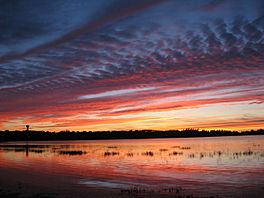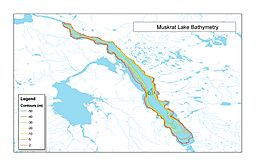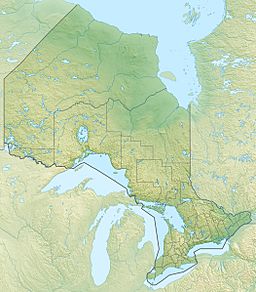Muskrat Lake facts for kids
Quick facts for kids Muskrat Lake |
|
|---|---|
 |
|

Map of Depths in Muskrat Lake Provided by the Muskrat Watershed Council
|
|
| Location | Whitewater Region, Ontario, Canada |
| Coordinates | 45°40′41″N 76°54′29″W / 45.678°N 76.908°W |
| Primary inflows | Muskrat River and Buttermilk Creek at Forester Falls Road |
| Primary outflows | Muskrat River at Highway 17 |
| Basin countries | Canada |
| Max. length | 16 km (9.9 mi) |
| Surface area | 1,219 ha (3,010 acres) |
| Average depth | 17.9 m (59 ft) |
| Max. depth | 64 m (210 ft) |
| Islands | 1 |
| Settlements | Cobden, Ontario |
Muskrat Lake is a beautiful lake located in the Whitewater Region of Renfrew County, Ontario, Canada. It's about 16 kilometers (10 miles) long and can be as deep as 64 meters (210 feet)! Many people live around the lake, with over 300 homes and two campgrounds. The biggest town nearby is Cobden, which has about 1,000 people.
Muskrat Lake is famous for a fun legend: locals say a mysterious lake monster, nicknamed “Mussie”, lives in its waters!
Contents
How Muskrat Lake Formed
Muskrat Lake was created around 10,000 years ago. This happened when the huge glaciers from the last ice age melted away. At first, it was part of a much bigger ancient sea called the Champlain Sea.
About 6,000 years ago, the water levels dropped. The Champlain Sea disappeared, leaving behind the lake we now call Muskrat Lake.
Water Flow in the Lake
Three main streams feed water into Muskrat Lake. These are the Muskrat River and Buttermilk Creek from the east, and the Snake River from the south. Water then flows out of Muskrat Lake into the Muskrat River again. This river then travels north towards Pembroke, Ontario and eventually joins the mighty Ottawa River.
A Look Back in Time
Samuel de Champlain's Visit in 1613
Long ago, the Algonquin people lived around Muskrat Lake. The first European explorer to see the lake was Samuel de Champlain on June 7, 1613. He was looking for a new way to reach the Northern Sea (now called Hudson Bay). This new route would help him avoid dangerous rapids on the Ottawa River.
During his trip, Champlain met a group of Algonquins led by Nibachis near the lake. Champlain named the lake "Lac De Nibachis" after him. Nibachis gave Champlain guides, and they traveled by canoe across the lake. They then carried their canoes a short distance to meet another chief, Tessoὒat.
The Lost Astrolabe
During his 1613 journey, Champlain lost his astrolabe. An astrolabe was an old tool used to measure the positions of stars and help with navigation.
More than 200 years later, in 1867, a 15-year-old boy named Edward G. Lee made an amazing discovery! He was helping his father clear land near Cobden when he found Champlain's lost astrolabe. Today, a resort called Logos Land is on part of this land.
The astrolabe was bought by the Canadian Government in 1989 for $250,000. It is now on display at the Museum of Civilization in Ottawa. A stone monument was put up near Logos Land in 1952 to remember this special find.
Ferries and Travel on Muskrat Lake
In 1837, explorer David Thompson tried to map a route for a canal. This canal would connect the Ottawa River to Georgian Bay, passing through Muskrat Lake. However, the canal was never built.
Later, in 1848, a man named Jason Gould started a transportation service. It went from Portage-du-Fort on the Ottawa River to Pembroke. This route included a ferry service across Muskrat Lake. It was a shorter and easier way to travel than the main Ottawa River route.
The first ferries were simple rowboats. Passengers had to paddle them! Soon, the first steamboat on Muskrat Lake, called The Muskrat, was built. Another steamboat, the North Star, joined it in 1853. The North Star was very long, over 90 feet!
On May 16, 1853, a huge forest fire swept through the area. It burned from Pembroke all the way to Horton, Ontario. The fire destroyed Jason Gould's dock, his storage buildings, and his steamboat, The Muskrat. Luckily, the North Star survived because it was out on the lake during the fire.
The ferry service on Muskrat Lake ended in 1876 when the railroad arrived in Cobden.
Community Life on the Lake
Muskrat Lake has always been important to the people living around it.
- In 1865, children going to Cobden's Elementary School would skate or row across the lake every day to get to class.
- In 1912, the Cobden Women's Institute held a picnic by the lake. It even included a steamboat ride!
- That same year, a local resident, Peter Pappin, caught a huge 65-pound lake sturgeon in Muskrat Lake.
- In 1961, Premier Frost arrived by float plane on Muskrat Lake to open the newly rebuilt Cobden Memorial Hall.
- Only two people are recorded to have swum across Muskrat Lake: Lawrence Dack in 1923 and Sarah Hall in 2017.
- Since 2010, the Cobden Civitan Club hosts a popular Ice Fishing Derby on the lake every winter. In 2020, over 1,500 people took part!
Lake Life and Wildlife
Muskrat Lake is full of different kinds of plants and animals, both in the water and on land. It's a popular spot all year for people who love nature. Bird watchers, outdoor fans, anglers (people who fish), and duck hunters all enjoy the lake.
Fish and Birds
The lake is known for its many types of freshwater fish. You can find:
The public dock at the east end of the lake is a great place for bird watchers. They have seen many different birds there, including Franklin's gull.
Environmental Concerns
Over the past few decades, the water quality in Muskrat Lake has become a concern. This is mainly due to something called nutrient loading.
What is Nutrient Loading?
Nutrient loading means that too many nutrients, like phosphorus and nitrogen, are getting into the lake. These nutrients often come from things like fertilizers used on farms or lawns, and from septic systems.
When there are too many nutrients, it can cause problems for the lake. It affects:
- People who own property along the shore.
- Those who use the lake for fun activities.
- Fish and their homes in the water.
- Even public health, because of something called blue-green algae.
Blue-Green Algae Blooms
One of the biggest problems from too much nutrient loading is the growth of blue-green algae. These are tiny organisms that can multiply very quickly, forming what are called "blooms."
When these blue-green algae blooms break down, they can release toxins into the water. These toxins can be harmful to:
- Humans
- Pets
- Farm animals
- Fish
- Other wildlife
Muskrat Lake has seen more and more blue-green algae blooms in recent years. Between 2007 and 2013, the Ministry of Environment confirmed these blooms three times.


